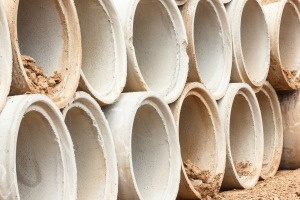 In concrete production, water and cement react to bind together fine aggregates (primarily sand) and coarse aggregates such as crushed stone or natural gravel. A relatively small amount of water is needed to initiate this chemical reaction (hydration) to transform the ingredients into concrete.
In concrete production, water and cement react to bind together fine aggregates (primarily sand) and coarse aggregates such as crushed stone or natural gravel. A relatively small amount of water is needed to initiate this chemical reaction (hydration) to transform the ingredients into concrete.
However, additional water is often required to make the mix workable enough to be poured and finished, and the addition of too much extra water can decrease the strength of finished concrete. Reduced durability in concrete can lead to a premature need for repairs or replacement in the residential and nonresidential building sectors, as well as in such public projects as highways, streets, bridges, and dams.
Superplasticizers Help Keep Concrete Strong
An important component of most modern concrete mixes, water reducers improve the workability of wet concrete while decreasing the amount of water used in the mix. Among water reducers, superplasticizers, also known as high-range water reducers, represent one of the fastest-growing chemical additives in the cement and concrete additives market according to Minor Cline, analyst with The Freedonia Group.
Composed of more advanced, higher-value chemicals than standard and mid-range water reducers, superplasticizers decrease the water-cement ratio while providing such benefits as:
- increased density
- improved bond strength
- greater volume stability and reduced shrinkage cracking
- increased abrasion resistance
- decreased permeability
- reduced segregation and bleeding
- higher early and ultimate strength
As such, these additives are used increasingly in technologically advanced high-performance concrete, self-consolidating concrete, and other demanding applications.
Superplasticizers are manufactured by most major producers of chemical admixtures, among them BASF, Euclid Chemical, Fritz-Pak, GCP Applied Technologies, and GEO Specialty Chemicals.
Superplasticizer Innovation: Improving Concrete Rheology Properties & Lowering Dosage Requirements
In recent years, major players in the cement and concrete additives industry have brought new superplasticizers to market in a continuing effort to improve concrete rheology properties and lower the dosage requirements of these important additives. In June 2015, BASF introduced MasterEase, a superplasticizer designed to enhance the rheological characteristics of high-performance low-viscosity concrete. In October 2015, Fritz-Pak announced the commercial launch of Supercizer PCE, a polycarboxylate ether-based superplasticizer that requires a lower dosage than many competing products. In August 2016, GCP Applied Technologies debuted TYTRO WR high range water-reducing admixtures as part of its new TYTRO Shotcrete System, which comprises a set of admixtures designed for shotcrete used in underground construction applications.
Learn More About Cement & Concrete Additives
For more information on superplasticizers and other cement and concrete additives, see The Freedonia Group’s study Cement & Concrete Additives. This comprehensive industry study presents historical demand data plus forecasts by type of additive (fiber, chemical, mineral) and market (nonresidential building, residential building, highway and street, other). The study also considers market environment factors, assesses the industry structure, and evaluates company market share.
About the Author: Aaron Hackle is a Writer/Researcher at The Freedonia Group, where he covers a diverse range of topics including industrial components, energy and petroleum, chemicals, packaging, and more.


